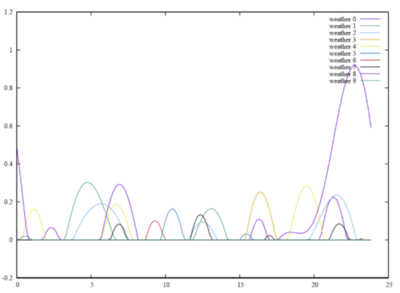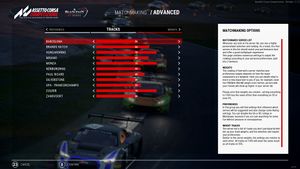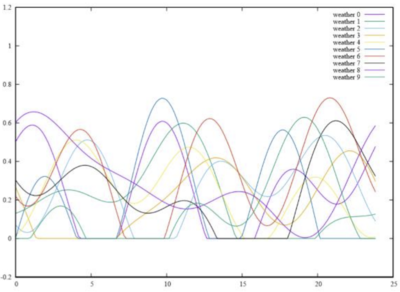Multiplayer Overview
Variants of Servers
The ACC Multiplayer is split into three sections. Server Admins can configure and run custom servers for the first two parts. To learn how to set up a custom server, read here: Server Configuration
| Variants | Description |
|---|---|
| Public Multiplayer Server | ACC drivers can access public MP servers by clicking the large "Quickjoin" button or selecting a server in the "Server List". These servers have only a limited number of options. |
| Private Multiplayer Server | This category includes the servers that are password protected. The server operator can make more complex settings there. If you want to join such a server, please find out which rules apply there.
|
| Competition Server | This is the official server where you can earn points for your driver profile and gain Competition Rating (CP). Overall, such an event can take up to 1.5 hours (Q25min / R60min).
|
Matchmaking in ACC
The Matchmaking feature in ACC is very simple. It allows you to "quickjoin" a server based on the drivers on that server, their skill level, your ping to the server, and so on. You can also pick and join a server manually. To join a server, go to the Main Menu and click Multiplayer.
- Automatic server join:
- Under "Matchmaking Options" set your preferences and click back.
- Then, click on the large field "Quickjoin", and you will be immediately logged on to a public server matching your preferences.
- Manual server join:
- Click on "Server list".
- Set your preferences under "Advanced" and click back.
- Choose a server by clicking on it.
- Click join.
Multiplayer Server Features
Servers can have different weather, weekend, and track state settings.
Race Weekend
Each server cycle will simulate a race weekend. The configuration starts at Friday night, and simulates weather, track conditions including support program race traffic until the first session configured. With active dynamic weather this means each weekend is unique and unpredictable, while the configuration determines how plausible, subtle or crazy the weekend will feel like.
Weather
The comprehensive weather system will start Friday night and evolve around the baseline values of clouds, rain and temperatures. It is linked to the time of the day, which means running a higher time multiplier in a session will also accelerate the rate of weather changes.
Weather will drive temperatures, sun impact, wind and cloud levels which can lead to rain. Low “weatherRandomness” enables a realistic evolvement while having a plausible and stable day. A simulation of 10 different days with a value of 3 or 4 could produce such rain flows:
 Figure 1:example calculation of 10 days with low/medium randomness; y = rain %, x = hour of day
Figure 1:example calculation of 10 days with low/medium randomness; y = rain %, x = hour of day
You see most of the days have some rain mixed in but are dry in most of the time. That means the chance to witness rain during a 20-minute session is low but can happen. Extending the time by either longer sessions or higher time multipliers will raise the chance.
Also note that most rain showers are in the “light/medium rain” region, only one day delivered a full thunderstorm. This is where the baseline of both “cloudLevel” and “rain” play an important role; raising either will make rain more probable.
Raising the “weatherRandomness” towards the upper end causes more extreme scenarios, where the weather is changing a lot often per day, and is allowed to leave the baseline values more easily. A more extreme case would be around values 5 or 6:
It’s clear how both frequencies and amplitudes change. While this looks nice and sensational, we do not recommend to use extreme values. Even if there is no rain, a value of 2 will already notably shift around clouds, temperatures and wind – but in a way you can still understand what is going on while sitting in a race car. If the temperatures for example raise and drop by 5°C within minutes, most users will constantly have the feeling that something is wrong and they don’t understand what it is.
So please feel free to experiment with those values and create a cool server setup, but keep in mind that it doesn’t have to reliably rain and stop twice within a 20 minute race session, and that users have to have a chance to follow the weather development.
Track
During a Blancpain race weekend, many different things are going to influence the track conditions. Friday night, we will start with fairly low or no rubber line, and a dusty track in general. Once the support programs start to run, the track will get a bit cleaner and build up rubber. How your first session looks like strongly depends on the race day you set up – Friday morning before 10am will give you the virgin track, while Saturday evening is already quite good grip. If it didn’t rain in between of course; high weather variation will of course often wash out the track. But as we also simulate the traffic of the other series during the weekend, you may find yourself in wet track with low/no rain, and the dry line started to form. Or the opposite, your session may find a really rubbered ideal line while it just starts to rain (beware, highly slippery).
Unlike the weather, the track is not affected by the time multiplier, and always “runs” in real time. That means even if you have a quick thunderstorm for one minute, your track won’t immediately rush to full wetness levels, and it also will dry out in real time. The water dissipation rate depends on sun angle, cloud level, temperatures and wind. That means a hot, sunny mid-day scenario may clean up the track within minutes, while you can still find the track wet and full of puddles after a cold night (no sun) or cloudy hours.
Again, having realistic and plausible weather settings will help users to understand what is going on based on their every-day experience, which in the end makes their experience better – be careful with extreme weather settings and time multipliers. It is also recommended to think about the real track observations; Locations like Spa or Nürburgring tend to have unlimited amounts of surprises, while Barcelona is known to be quite stable and hot (I’ll deliberately leave out the Italian tracks here, after having visited them in 2018 and 2019).
In a recap, we exposed very few parameters to a quite complex system, and playing with those will vastly influence the experience on your server. It is worth to learn and experiment with those settings!
Server Configuration
You have the option to run a server on your PC (LAN) or rent one from providers of Dedicated Servers. See here: Server Configuration.

